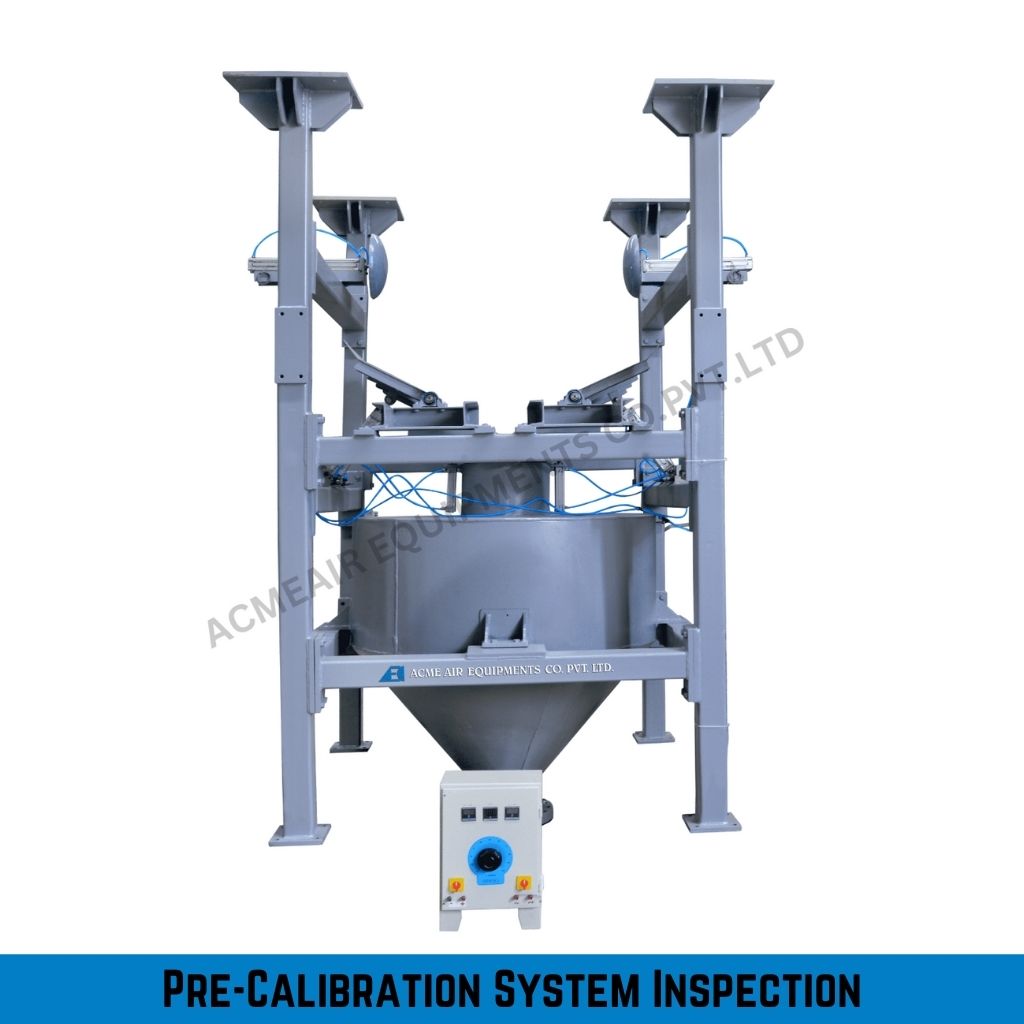Table of Contents
A Big Bag Unloading System is a key component for efficiently transferring bulk materials from large bags (FIBC bags) to a processing system, hopper, or other downstream equipment. Calibration and testing are crucial steps in ensuring that the system functions accurately, safely, and efficiently. This article provides a step-by-step illustrated procedure on how to calibrate and test a big bag unloading system, ensuring it operates optimally and meets the required performance standards.
Objective of the Article:
The objective of this article is to:
- Provide a clear, step-by-step guide for calibrating and testing a big bag unloading system, ensuring that the system operates efficiently and safely.
- Educate engineers, operators, and maintenance personnel on how to check the system’s accuracy and performance, including material flow rates, hoist operation, and dust control systems.
- Help identify and troubleshoot common issues that may arise during the calibration and testing processes.
- Ensure that the system complies with safety standards, performs within the desired parameters, and is ready for full operational use.
By the end of this article, readers will understand how to calibrate the system, conduct accuracy checks, and troubleshoot potential issues during the testing phase.
Step-by-Step Procedure for Calibrating and Testing a Big Bag Unloading System
Preliminary Checks and Preparation
Before starting the calibration and testing process, ensure that the system components are in place and functioning correctly.
Step 1.1: Inspect Components
- Verify System Setup: Ensure that the hoist, frame, discharge system, and hopper are installed properly.
- Check for Wear and Tear: Inspect the moving parts, such as the hoist mechanism, trolley, and discharge system, for any signs of wear or damage.
- Safety Precautions: Ensure that the system is locked out and tagged out (if necessary) before proceeding. Wear personal protective equipment (PPE), such as gloves, goggles, and a hard hat.

Step 1.2: Ensure Proper Material Handling Setup
- Confirm that the material discharge system (such as a vibratory feeder or screw conveyor) is properly connected to the hopper.
- Ensure that the dust collection system is set up and functioning to prevent dust release during the unloading process.
Calibrating the Hoist and Trolley System
The hoist and trolley system is responsible for lifting and moving the big bag into position. Proper calibration ensures that these components perform smoothly without putting strain on the system.
Step 2.1: Check the Hoist Capacity
- Hoist Weight Capacity: Confirm that the hoist’s weight capacity aligns with the weight of the big bag, including the material it holds.
- Test the Lifting Mechanism: Using the control panel, lift and lower the hoist with a test bag to ensure it operates smoothly and without jerks or unusual resistance.
Step 2.2: Trolley Movement Calibration
- Ensure the trolley moves smoothly along the rail. Test the lateral movement to make sure it can position the big bag properly above the discharge point.
- If the system has manual or automated controls, check that both settings are functioning correctly.
Calibrating the Material Discharge System
The discharge system controls the flow of materials from the big bag into the processing equipment. Ensuring accurate discharge is critical for the operation of the entire system.
Step 3.1: Verify Flow Control
- Adjust Flow Rate: Use the control panel to set the desired flow rate for the material. Ensure that the flow is consistent and that material moves into the hopper at the correct rate.
- Check for Blockages: Confirm there are no blockages or flow restrictions in the discharge system. Look for any signs of material clogging in the pipes or chutes.
Step 3.2: Test the Vibratory Feeder or Screw Conveyor
- Vibratory Feeder: If using a vibratory feeder, check that the vibrations are uniform and effective at moving material. Adjust the speed or intensity if necessary.
- Screw Conveyor: For screw conveyors, check that the conveyor rotates freely without obstruction and that the material is moved efficiently.
Calibration of the Dust Collection System
If your big bag unloading system includes a dust collection system, it is essential to calibrate it to prevent dust buildup and ensure a clean environment.
Step 4.1: Check Dust Filter Operation
- Ensure that the dust filters are functioning properly, capturing airborne particles as material is unloaded.
- Adjust the Fan Speed: If the system includes a fan for suction, ensure that the fan speed is set correctly for optimal dust extraction.
Step 4.2: Inspect for Leaks
- Check Seals: Inspect all seals and joints in the dust collection system for air or material leaks. Leaks can reduce system efficiency and contribute to air contamination.
- Test the Baghouse: If your system uses a baghouse for dust collection, check that the filter bags are clean and in good condition.
Testing the System for Accuracy
Once all calibration steps are complete, perform a series of tests to verify that the system is operating as expected.
Step 5.1: Conduct a Dry Run
- Simulate Operation: Without loading material into the system, run the entire unloading process. Monitor the movement of the hoist, the discharge system, and the dust collection system to ensure smooth operation.
- Check System Parameters: Ensure that the hoist speed, material flow rate, and dust collection are all within acceptable ranges.
Step 5.2: Load Test
- Unloading Test: Load a big bag with a sample material (similar to what the system will be handling) and test the unloading procedure.
- Monitor Performance: During the unloading process, check the material flow, discharge efficiency, and dust collection. Ensure there are no blockages, leaks, or excessive material spillage.
Step 5.3: Adjust for Optimal Performance
- Fine-tune Controls: After the test, make any necessary adjustments to the flow rates, hoist speed, or dust collection settings.
- Re-test: Run the system again with adjustments and check that the results are consistent with the desired performance.
Final System Verification
Once the system is calibrated and tested, it’s time for final checks.
Step 6.1: Operator Training
Ensure that all operators are trained on the system’s controls, safety features, and maintenance procedures. Provide clear instructions on how to operate the system, troubleshoot issues, and handle the unloading process.
Step 6.2: Document Calibration Results
Record the results of all calibration and testing procedures. Keep these records for reference during future maintenance or troubleshooting.
FAQs:
Why is calibration important for a Big Bag Unloading System?
Calibration ensures that the system operates efficiently and safely, preventing issues like material spillage, uneven flow, and poor dust control. It also ensures the equipment operates within the manufacturer’s specified parameters for optimal performance.
How do I know if the hoist is calibrated correctly?
The hoist should lift and lower the big bag smoothly, without jerking or straining. If you notice any unusual noise or resistance, it may need further calibration or maintenance.
How often should I calibrate my Big Bag Unloading System?
Calibration should be done initially after installation, then periodically as part of routine maintenance (e.g., every six months or after major system changes). If you notice performance issues, recalibration may be necessary.
What are the common issues to look out for during calibration?
Common issues include blockages in the discharge system, inconsistent material flow, dust leakage, and improper hoist operation. These issues can affect the efficiency of the unloading process and need to be addressed during calibration.
How do I test the dust collection system?
You can test the dust collection system by running the system with test material and checking if the dust is properly captured. Ensure that filters are clean, fans are functioning, and there are no air leaks.
Can I automate the calibration and testing process?
Some advanced systems allow for automated calibration and testing via digital control panels or integrated PLC systems. These systems can adjust settings automatically based on the desired parameters.
How do I maintain the system after calibration?
Regular maintenance should include cleaning the filters, checking the hoist mechanism for wear, inspecting the dust collection system, and monitoring the material flow rates. Perform regular inspections to ensure consistent performance.
Conclusion
Calibrating and testing a Big Bag Unloading System is crucial to ensuring efficient, safe, and reliable operation. By following this step-by-step illustrated guide, engineers and operators can ensure that the system is properly set up and functioning at its best. Regular calibration, along with periodic testing, helps avoid downtime, reduces the risk of operational issues, and prolongs the life of the equipment.
About Author

CEO
Mr. Vishwesh Pardeshi is the CEO of Acme Air Equipments Company Pvt. Ltd., an industrial and engineering goods manufacturing company based in Ahmedabad, Gujarat (India). He has taken over the responsibility from founding Partners and Directors of the Company, and is now leading a talented group of professionals since 2020 by bringing in vast industrial and management expertise. By qualification, he holds a Bachelor Degree in Mechanical Engineering and also holds a MBA degree from reputed institutes. Under his leadership, the Company has successfully executed prestigious projects by delivering high quality and world class products from a state of the art manufacturing facility which combines CNC-enabled precision manufacturing and strong after sales support. In line with the Vision, Mission and Core Values of the Organization, Mr. Vishwesh Pardeshi continues to drive Quality, Reliability and Global Expansion at Acme Air Equipments Co. Pvt. Ltd.









